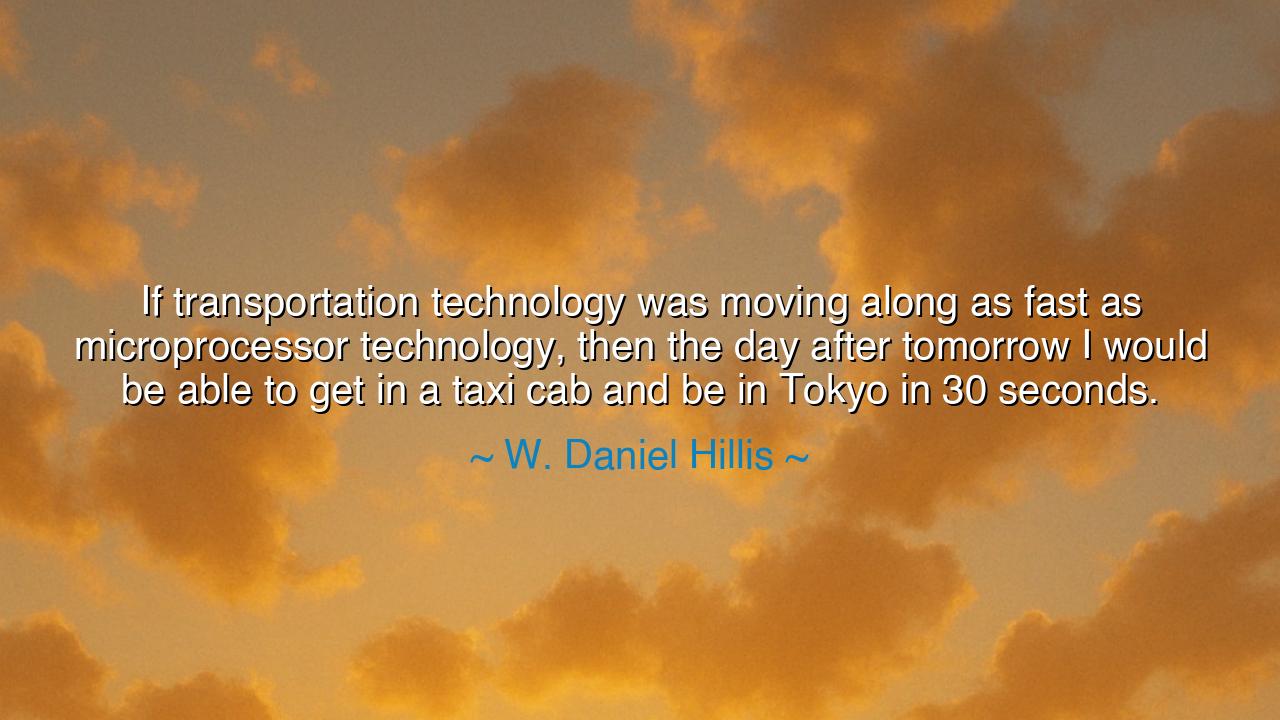
If transportation technology was moving along as fast as
If transportation technology was moving along as fast as microprocessor technology, then the day after tomorrow I would be able to get in a taxi cab and be in Tokyo in 30 seconds.






Hear the wondrous words of W. Daniel Hillis, computer scientist and dreamer of vast possibilities, who declared: “If transportation technology was moving along as fast as microprocessor technology, then the day after tomorrow I would be able to get in a taxi cab and be in Tokyo in 30 seconds.” In this vision we see the power of comparison: the breathtaking speed of progress in one domain, and the slower, weightier path in another. It is a cry of astonishment, a reminder of how swiftly human ingenuity has advanced in the realm of computation, and how far it might yet go in all other realms.
The origin of this saying lies in Hillis’s deep immersion in the birth of the digital age. As one of the pioneers in designing parallel computers, he watched microprocessor power grow at an exponential pace, doubling year after year, transforming the world from typewriters to supercomputers in a mere generation. To illustrate the magnitude of this change, he reached for the metaphor of transportation, for all men understand distance and travel. If planes, trains, and cars had advanced as quickly as processors, journeys that once took days would shrink to seconds. The image of a taxi crossing the world in a heartbeat makes tangible the dizzying force of technological acceleration.
History offers us mirrors of this astonishment. Consider the dawn of the steam engine in the 19th century. For millennia, mankind had traveled only as fast as horses and sails could carry them. But with steam, journeys once measured in weeks shrank to days. The world itself seemed to contract, empires grew, and cultures collided. What Hillis describes with microprocessors is of even greater magnitude: a compression not of oceans and continents, but of time itself, as computations that once required lifetimes are now completed in moments.
Yet hidden in his words is also a warning. For though the mind may leap across the earth in 30 seconds, the body and society do not move so swiftly. The danger of such imbalance is clear: when one aspect of progress accelerates beyond all proportion, the others struggle to keep pace. The marvel of microprocessors gave birth to the internet, to global networks, to instant communication—but our laws, our ethics, and our ways of living remain far slower to adapt. Thus, Hillis’s metaphor of taxis to Tokyo is not only wonder, but also caution: beware when technology outstrips wisdom.
We can see this lesson in the story of the Manhattan Project. In a few short years, the physics of the atom leapt forward at a speed that stunned even its masters, producing a power greater than any in human history. Yet the wisdom to govern such power lagged behind, and the world entered the shadow of nuclear fear. So too, in our digital age, microprocessors may carry us forward in seconds, but the moral and social framework that guides their use must not be left behind, lest our speed become our destruction.
The heart of Hillis’s wisdom is awe: to remind us never to take for granted the sheer acceleration of microprocessor technology, and to dream of what might come if such momentum could be harnessed in other domains of life. But the deeper teaching is responsibility. For while it is easy to marvel at the idea of instant taxis to Tokyo, we must ask: are we ready to live in such a world? Have we trained our minds, our laws, and our spirits to move at the pace of our machines?
So I say to you, children of tomorrow: marvel at the speed of progress, but do not be blinded by it. Let Hillis’s words remind you both of human greatness and of human frailty. Celebrate the wonders of computation, but also labor to bring wisdom, morality, and society into harmony with the tools we create. Dream boldly, yes—but temper the dream with patience. For technology is the engine, but wisdom is the pilot; and only when both move together will we travel not only swiftly, but rightly, into the future.






AAdministratorAdministrator
Welcome, honored guests. Please leave a comment, we will respond soon